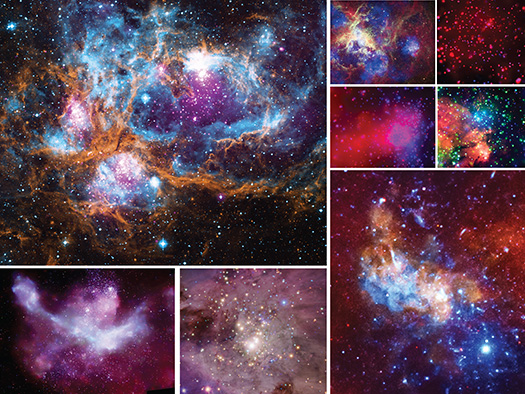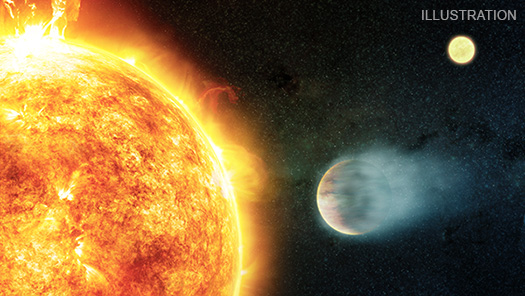NASA's Chandra, Webb Combine for Arresting Views
Submitted by chandra on Tue, 2023-05-23 12:35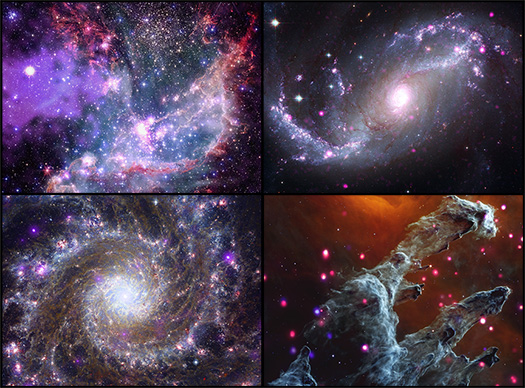
NGC 346, NGC 1672, M74 & M16
Credit: X-ray: Chandra: NASA/CXC/SAO, XMM: ESA/XMM-Newton; IR: JWST: NASA/ESA/CSA/STScI, Spitzer: NASA/JPL/CalTech; Optical: Hubble: NASA/ESA/STScI, ESO; Image Processing: L. Frattare, J. Major, N. Wolk, and K. Arcand
Four composite images deliver dazzling views from NASA's Chandra X-ray Observatory and James Webb Space Telescope of two galaxies, a nebula, and a star cluster. Each image combines Chandra's X-rays — a form of high-energy light — with infrared data from previously released Webb images, both of which are invisible to the unaided eye. Data from NASA's Hubble Space Telescope (optical light) and retired Spitzer Space Telescope (infrared), plus the European Space Agency's XMM-Newton (X-ray) and the European Southern Observatory's New Technology Telescope (optical) is also used. These cosmic wonders and details are made available by mapping the data to colors that humans can perceive.
A Rocking Space Duet Featuring an Explosive Riff
Submitted by chandra on Fri, 2023-03-10 13:52R Aquarii, All Wavelengths
Credit: X-ray: NASA/CXC/SAO/R. Montez et al.; Optical: Data: NASA/ESA/STScI, Enhanced processing by Judy Schmidt (CC BY-NC-SA). X-ray/Optical composite processing by CXC/N. Wolk & K.Arcand; Sonification: NASA/CXC/SAO/K.Arcand, SYSTEM Sounds (M. Russo, A. Santaguida)
The system called R Aquarii unfolds dramatically through the eyes of NASA’s Chandra X-ray Observatory (purple) and Hubble Space Telescope (red and blue). The spectacular structures outlined in the Hubble data are old notes, or in other words, evidence from outbursts generated by a pair of stars buried at the center of the image. X-rays from Chandra reveal how a jet from one of these stars — a cool stellar ember known as a white dwarf — is banging into the material surrounding it. This high-powered flow creates shock waves, similar to sonic booms from planes that move faster than the speed of sound. The other player with the white dwarf in this interstellar duet is a red giant star. As they orbit each other, the white dwarf pulls material from the red giant onto its surface. Over time, enough of this material accumulates and triggers an explosion. Astronomers have seen such outbursts over recent decades and this dynamic chorus will likely go on for millennia to come.
The Enduring Stellar Lifecycle in 30 Doradus
Submitted by chandra on Thu, 2023-01-05 10:50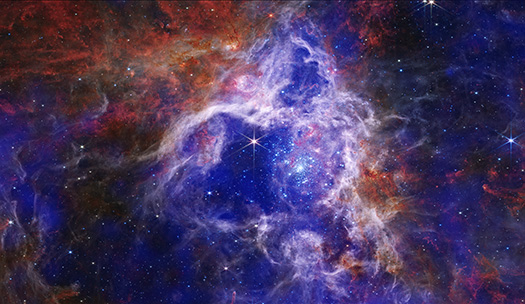
30 Doradus
Credit: X-ray: NASA/CXC/Penn State Univ./L. Townsley et al.; IR: NASA/ESA/CSA/STScI/JWST ERO Production Team
The largest and brightest region of star formation in the Local Group of galaxies, including the Milky Way, is called 30 Doradus (or, informally, the Tarantula Nebula). Located in the Large Magellanic Cloud, a small neighbor galaxy to the Milky Way, 30 Doradus has long been studied by astronomers who want to better understand how stars like the Sun are born and evolve.
NASA’s Chandra X-ray Observatory has frequently looked at 30 Doradus over the lifetime of the mission, often under the direction of Dr. Leisa Townsley who passed away in the summer of 2022. These data will continue to be collected and analyzed, providing opportunities for scientists both now and in the future to learn more about star formation and its related processes.
This new composite image combines the X-ray data from Chandra observations of 30 Doradus with an infrared image from NASA’s James Webb Space Telescope that was released in the fall of 2022. The X-rays (royal blue and purple) reveal gas that has been heated to millions of degrees by shock waves — similar to sonic booms from airplanes — generated by the winds from massive stars. The Chandra data also identify the remains of supernova explosions, which will ultimately send important elements such as oxygen and carbon into space where they will become part of the next generation of stars.
The Enduring and Engaging Legacy of Leisa Townsley
Submitted by chandra on Thu, 2023-01-05 10:29When Dr. Leisa Townsley passed away this summer, the scientific community lost a brilliant researcher, teacher, and mentor. She was all of those things, but we wanted to feature some of the pivotal and critical ways that she helped the Chandra X-ray Observatory, specifically our Communications and Public Engagement work.
Chandra was launched into space in 1999 and with the beginning of its successful operations, a new era in high-energy astrophysics was born. For certain deep space objects that emitted enough X-ray photons, Chandra brought, for the first time, the ability to create richly detailed, high-resolution images. These X-ray images, however, were different in many ways from the images of its previously-launched sister Great Observatory, the Hubble Space Telescope.
Establishing a visual identity for Chandra, both on its own and in collaboration with other telescopes that study different kinds of light, including Hubble, was no small challenge. Our Chandra group was responsible for finding the best way to show X-ray data, which often looks completely different from optical data. Would traditional techniques used for visible light data be suitable to process X-ray data? Would new processes and tactics need to be developed to make X-ray data more accessible, easier to understand and process?
Chandra Sees Stellar X-rays Exceeding Safety Limits
Submitted by chandra on Thu, 2022-12-15 09:29
NGC 3293
Credit: X-ray: NASA/CXC/Penn State Univ./K. Getman et al.; Infrared: ESA/NASA JPL-Caltech/Herschel Space Observatory/JPL/IPAC; NASA JPL-Caltech/SSC/Spitzer Space Telescope; Optical: MPG/ESO/G. Beccari;
Astronomers have made the most extensive study yet of how magnetically active stars are when they are young. This gives scientists a window into how X-rays from stars like the Sun, but billions of years younger, could partially or completely evaporate the atmospheres of planets orbiting them.
Many stars begin their lives in “open clusters,” loosely packed groups of stars with up to a few thousand members, all formed roughly at the same time. This makes open clusters valuable for astronomers investigating the evolution of stars and planets, because they allow the study of many stars of similar ages forged in the same environment.
A team of astronomers led by Konstantin Getman of Penn State University studied a sample of over 6,000 stars in 10 different open clusters with ages between 7 million and 25 million years. One of the goals of this study was to learn how the magnetic activity levels of stars like our Sun change during the first tens of millions of years after they form. Getman and his colleagues used NASA’s Chandra X-ray Observatory for this study because stars that have more activity linked to magnetic fields are brighter in X-rays.
Astronomers See Stellar Self-Control in Action
Submitted by chandra on Tue, 2022-11-29 08:46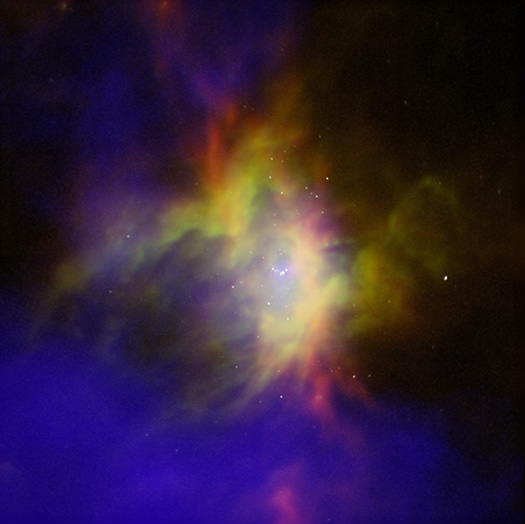
RCW 36
Credit: X-ray: NASA/CXC/Ames Research Center/L. Bonne et al.; Infrared: ESA/NASA.JPL-Caltech/Herschel Space Observatory/JPL/IPAC
Many factors can limit the size of a group, including external ones that members have no control over. Astronomers have found that groups of stars in certain environments, however, can regulate themselves.
A new study has revealed stars in a cluster having “self-control,” meaning that they allow only a limited number of stars to grow before the biggest and brightest members expel most of the gas from the system. This process should drastically slow down the birth of new stars, which would better align with astronomers’ predictions for how quickly stars form in clusters.
This study combines data from several telescopes including NASA's Chandra X-ray Observatory, NASA's now-retired Stratospheric Observatory for Infrared Astronomy (SOFIA), the APEX (the Atacama Pathfinder EXperiment) telescope, and ESA’s (European Space Agency’s) retired Herschel telescope.
Planets Can Be Anti-Aging Formula for Stars
Submitted by chandra on Wed, 2022-11-02 10:07An artist’s illustration shows a gas giant planet (lower right) closely orbiting its host star (left), with another star in the distance (upper right). The two stars are themselves in orbit with each other. As explained in our latest press release, a team of scientists used NASA’s Chandra X-ray Observatory and ESA’s XMM-Newton to test whether such exoplanets (known as “hot Jupiters”) affect their host star in comparison to the star that does not have one. The results show that these exoplanets can make their host star act younger than it is by causing the star to spin more quickly than it would without such a planet.
The double-star (or “binary”) system in the illustration is one of dozens that astronomers studied using Chandra and XMM-Newton to look for the effects of hot Jupiters on their host stars. A hot Jupiter can potentially influence its host star by tidal forces, causing the star to spin more quickly than if it did not have such a planet. This more rapid rotation can make the host star more active and produce more X-rays, making it appear younger than it really is.
Embracing a Rejected Star
Submitted by chandra on Mon, 2022-07-25 11:51
Zeta Ophiuchi
Credit: X-ray: NASA/CXC/Dublin Inst. Advanced Studies/S. Green et al.; Infrared: NASA/JPL/Spitzer
Zeta Ophiuchi is a star with a complicated past, having likely been ejected from its birthplace by a powerful stellar explosion. A new look by NASA's Chandra X-ray Observatory helps tell more of the story of this runaway star.
Located about 440 light-years from Earth, Zeta Ophiuchi is a hot star that is 20 times more massive than the Sun. Previous observations have provided evidence that Zeta Ophiuchi was once in close orbit with another star, before being ejected at about 100,000 miles per hour when this companion was destroyed in a supernova explosion over a million years ago. Previously released infrared data from NASA's now-retired Spitzer Space Telescope, seen in this new composite image, reveals a spectacular shock wave (red and green) that was formed by matter blowing away from the star's surface and slamming into gas in its path. Data from Chandra shows a bubble of X-ray emission (blue) located around the star, produced by gas that has been heated by the effects of the shock wave to tens of millions of degrees.
Eta Carinae: Visualization Explores A Massive Star's Great Eruption
Submitted by chandra on Tue, 2022-01-25 08:15Video Credit: J. Olmsted, D. Player, L. Hustak, A. Pagan, J. DePasquale, G. Bacon, F. Summers (STScI), R. Hurt (Caltech/IPAC), NASA, ESA; Music: "Sleepy Frieda", Maarten Schellekens, CC BY-NC 4.0;
Image Credit: A. Fujii, J. Morse (BoldlyGo Inst), N. Smith (U Arizona), Hubble SM4 ERO Team, NASA, ESA, STScI, JPL-Caltech, CXC, ESO, NOAO, AURA, NSF
Eta Carinae, or Eta Car, is famous for a brilliant and unusual outburst, called the "Great Eruption", observed in the 1840s. This visualization presents the story of that event and examines the resulting multiwavelength emissions and three-dimensional structures surrounding Eta Car today.
Massive stars are known to have major outbursts. Eta Car, one of the most massive stars known, expelled about 10% of its mass in the Great Eruption, creating a small nebula, called the Homunculus Nebula, around it. Images taken in different wavelengths of light reveal different structures, each providing more information about the outbursts of Eta Car.
For this visualization, astronomers and artists have used NASA observations to model both the close-up and wide views of this massive and eruptive star. The Hubble Space Telescope and the Chandra X-ray Observatory have observed the nested layers of gas and dust around Eta Car using visible, ultraviolet, and X-ray light, as well as in the Hydrogen alpha emission line. The Spitzer Space Telescope provides a larger view of the Carina Nebula, along with Eta Car's dominant position within this star-forming region.
X-ray Screams From Toddler Suns
Submitted by chandra on Tue, 2021-06-15 12:26
Konstantin Getman
We are very happy to welcome Dr. Konstantin Getman as our guest blogger, who is also the first author of the studies featured in our latest press release. He received an honor master's degree in astronomy at Moscow State University in 1994 and his Ph.D. degree in physics and mathematics at Pushkov Institute of Terrestrial Magnetism, Ionosphere and Radiowave Propagation of the Russian Academy of Sciences (IZMIRAN) in 1999. Since 2001, he has been at the Pennsylvania State University where he is currently a research professor. His research is focused on star formation and stellar activity, about which he authored and co-authored 80 peer-reviewed publications.
The Sun is covered with magnetic field lines like an animal is covered with fur. These twisted and sheared lines store a lot of “free” energy. When solar magnetic lines of opposite polarity come close to each other, they interact, change their topology, and release free energy, causing powerful and eruptive events, that scientists call “flares”. These flare processes include acceleration of charged particles in the Sun’s upper atmosphere (called the corona), emission of large amounts of radiation in various energy bands (such as radio, microwave, optical, and X-ray), and launching of streams of plasma and magnetic field into space (called coronal mass ejections, or CMEs).

